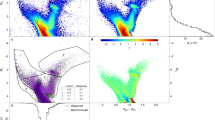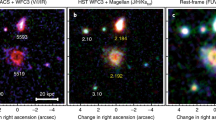Abstract
Like many galaxies of its size, the Milky Way is a disk with prominent spiral arms rooted in a central bar1, although our knowledge of its structure and origin is incomplete. Traditional attempts to understand our Galaxy’s morphology assume that it has been unperturbed by major external forces. Here we report simulations of the response of the Milky Way to the infall of the Sagittarius2 dwarf galaxy (Sgr), which results in the formation of spiral arms, influences the central bar and produces a flared outer disk. Two ring-like wrappings emerge towards the Galactic anti-Centre in our model that are reminiscent of the low-latitude arcs observed in the same area of the Milky Way. Previous models have focused on Sgr itself3,4 to reproduce the dwarf’s orbital history and place associated constraints on the shape of the Milky Way gravitational potential, treating the Sgr impact event as a trivial influence on the Galactic disk. Our results show that the Milky Way’s morphology is not purely secular in origin and that low-mass minor mergers predicted to be common throughout the Universe5 probably have a similarly important role in shaping galactic structure.
This is a preview of subscription content, access via your institution
Access options
Subscribe to this journal
Receive 51 print issues and online access
$199.00 per year
only $3.90 per issue
Buy this article
- Purchase on Springer Link
- Instant access to full article PDF
Prices may be subject to local taxes which are calculated during checkout




Similar content being viewed by others
References
Pohl, M., Englmaier, P. & Bissantz, N. Three-dimensional distribution of molecular gas in the barred Milky Way. Astrophys. J. 677, 283–291 (2008)
Ibata, R. A., Gilmore, G. & Irwin, M. J. A dwarf satellite galaxy in Sagittarius. Nature 370, 194–196 (1994)
Law, D. R., Johnston, K. V. & Majewski, S. R. A Two Micron All-Sky Survey view of the Sagittarius dwarf galaxy. IV. Modeling the Sagittarius tidal tails. Astrophys. J. 619, 807–823 (2005)
Law, D. R. & Majewski, S. R. The Sagittarius dwarf galaxy: a model for evolution in a triaxial Milky Way halo. Astrophys. J. 714, 229–254 (2010)
Johnston, K. V., Spergel, D. N. & Hernquist, L. The disruption of the Sagittarius dwarf galaxy. Astrophys. J. 451, 598–606 (1995)
Niederste-Ostholt, M., Belokurov, V., Evans, N. W. & Peñarrubia, J. Re-assembling the Sagittarius dwarf galaxy. Astrophys. J. 712, 516–526 (2010)
Conroy, C. & Wechsler, R. H. Connecting galaxies, halos, and star formation rates across cosmic time. Astrophys. J. 696, 620–635 (2009)
Behroozi, P. S., Conroy, C. & Wechsler, R. H. A comprehensive analysis of uncertainties affecting the stellar mass-halo mass relation for 0 < z < 4. Astrophys. J. 717, 379–403 (2010)
Widrow, L. M., Pym, B. & Dubinski, J. Dynamical blueprints for galaxies. Astrophys. J. 679, 1239–1259 (2008)
Bissantz, N. & Gerhard, O. Spiral arms, bar shape and bulge microlensing in the Milky Way. Mon. Not. R. Astron. Soc. 330, 591–608 (2002)
Nordström, B. et al. The Geneva-Copenhagen survey of the solar neighbourhood. Ages, metallicities, and kinematic properties of ∼14,000 F and G dwarfs. Astron. Astrophys. 418, 989–1029 (2004)
Dinescu, D. I., Girard, T. M., van Altena, W. F. & López, C. E. Absolute Proper Motion of the Sagittarius Dwarf Galaxy and of the Outer Regions of the Milky Way Bulge. Astrophys. J. 618, L25–L28 (2005)
Majewski, S. R., Skrutskie, M. F., Weinberg, M. D. & Ostheimer, J. C. A Two Micron All Sky Survey view of the Sagittarius dwarf galaxy. I. Morphology of the Sagittarius core and tidal arms. Astrophys. J. 599, 1082–1115 (2003)
Kunder, A. & Chaboyer, B. Distance to the Sagittarius dwarf galaxy using Macho Project RR Lyrae stars. Astron. J. 137, 4478–4486 (2009)
Lokas, E. L. et al. The inner structure and kinematics of the Sagittarius dwarf galaxy as a product of tidal stirring. Astrophys. J. 725, 1516–1527 (2010)
Peñarrubia, J. et al. A comprehensive model for the Monoceros tidal stream. Astrophys. J. 626, 128–144 (2005)
Momany, Y. et al. Outer structure of the Galactic warp and flare: explaining the Canis Major over-density. Astron. Astrophys. 451, 515–538 (2006)
Kazantzidis, S., Bullock, J. S., Zentner, A. R., Kravtsov, A. V. & Moustakas, L. A. Cold Dark Matter substructure and galactic disks. I. Morphological signatures of hierarchical satellite accretion. Astrophys. J. 688, 254–276 (2008)
Navarro, J. F., Frenk, C. S. & White, S. D. M. The structure of cold dark matter halos. Astrophys. J. 462, 563–575 (1996)
Zemp, M., Moore, B., Stadel, J., Carollo, C. M. & Madau, P. Multimass spherical structure models for N-body simulations. Mon. Not. R. Astron. Soc. 386, 1543–1556 (2008)
King, I. R. The profile of a star image. Publ. Astron. Soc. Pacif. 83, 199–201 (1971)
Keselman, J. A., Nusser, A. & Peebles, P. J. E. Galaxy satellites and the weak equivalence principle. Phys. Rev. D. 80, 063517 (2009)
Levine, E. S., Blitz, L. & Heiles, C. The spiral structure of the outer Milky Way in hydrogen. Science 312, 1773–1777 (2006)
Reid, M. J. et al. Trigonometric parallaxes of massive star-forming regions. VI. Galactic structure, fundamental parameters, and noncircular motions. Astrophys. J. 700, 137–148 (2009)
Sellwood, J. A. The lifetimes of spiral patterns in disc galaxies. Mon. Not. R. Astron. Soc. 410, 1637–1646 (2010)
Struck, C., Dobbs, C. L. & Hwang, J.-S. Slowly-breaking waves: the longevity of tidally induced spiral structure. Mon. Not. R. Astron. Soc. 414, 2498–2510 (2011)
Majewski, S. R. et al. A Two Micron All Sky Survey view of the sagittarius dwarf galaxy. II. Swope telescope spectroscopy of M giant stars in the dynamically cold Sagittarius tidal stream. Astron. J. 128, 245–259 (2004)
Correnti, M., Bellazzini, M., Ibata, R. A., Ferraro, F. R. & Varghese, A. The northern wraps of the Sagittarius stream as traced by red clump stars: distances, intrinsic widths, and stellar densities. Astrophys. J. 721, 329–356 (2010)
Grillmair, C. J. Substructure in tidal streams: tributaries in the anticenter stream. Astrophys. J. 651, L29–L32 (2006)
Ibata, R. A., Irwin, M. J., Lewis, G. F., Ferguson, A. M. N. & Tanvir, N. One ring to encompass them all: a giant stellar structure that surrounds the Galaxy. Mon. Not. R. Astron. Soc. 340, L21–L27 (2003)
Acknowledgements
We would like to thank K. Johnston, M. Kaplinghat, D. Law, H. Morrison and A. Zentner for discussions and C. Struck for suggestions that improved this work. All simulations were performed on the GreenPlanet cluster at the University of California, Irvine.
Author information
Authors and Affiliations
Contributions
C.W.P. helped to conceive the project, performed and analysed all simulations, and wrote the majority of the text. J.S.B. helped to conceive the project, contributed to the analysis, and co-authored the text. E.J.T. created the 3D visualizations and provided discussion and direction related to observational correlations. M.R. provided the code that was utilized to initialize the Sagittarius progenitors and insight on how to thereby achieve the desired properties of these systems. S.C. assisted with interpretation and analysis of the stellar disk instabilities and their time evolution.
Corresponding author
Ethics declarations
Competing interests
The authors declare no competing financial interests.
Supplementary information
Supplementary Information
This file contains Supplementary Figures 1-8 with legends, Supplementary Text and additional references. (PDF 9803 kb)
Rights and permissions
About this article
Cite this article
Purcell, C., Bullock, J., Tollerud, E. et al. The Sagittarius impact as an architect of spirality and outer rings in the Milky Way. Nature 477, 301–303 (2011). https://doi.org/10.1038/nature10417
Received:
Accepted:
Published:
Issue Date:
DOI: https://doi.org/10.1038/nature10417
This article is cited by
-
The recurrent impact of the Sagittarius dwarf on the star formation history of the Milky Way
Nature Astronomy (2020)
-
Gaia’s living and breathing Galaxy
Nature Reviews Physics (2019)
-
Two chemically similar stellar overdensities on opposite sides of the plane of the Galactic disk
Nature (2018)
-
A dynamically young and perturbed Milky Way disk
Nature (2018)
-
Order out of Randomness: Self-Organization Processes in Astrophysics
Space Science Reviews (2018)
Comments
By submitting a comment you agree to abide by our Terms and Community Guidelines. If you find something abusive or that does not comply with our terms or guidelines please flag it as inappropriate.



